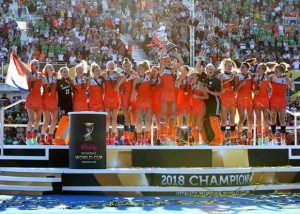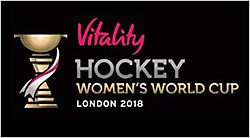BT Sport pulls out all the stops for Hockey Women’s World Cup
BT Sport used the Hockey Women’s World Cup, held in London July and early August, to showcase the sport to an international audience using the latest broadcast technologies and highest-ever production standards for hockey. BT Sport was on air for over 80 hours of hockey over 14 days, to 131 countries over five continents.

At the Hockey Women’s World Cup 2018, the Netherlands celebrate their eighth consecutive World Cup title
Between 21 July to 5 August 2018 at the Lee Valley Hockey and Tennis Centre in London, BT Sport pulled out all the stops for 4K coverage of this increasingly popular sport. BT Sport has been the UK rights holder for Fédération Internationale de Hockey (FIH) women’s hockey for the last three seasons starting in 2015 and has just signed for the next three seasons.
Jamie Hindhaugh, COO at BT Sport, told SVG Europe: “Our last three seasons as rights holders for the FIH culminated for us in providing coverage as host broadcaster for the World Cup in Lee Valley. We are full production partners with the FIH, and the World Cup, held just around the corner from us, was broadcast in its entirety around the world.”
He continued: “We’ve been championing women’s hockey for some time. This was one of the biggest ever live 4K OB events, with back to back, day in, day out coverage. We captured everything in 4K, and it was the first time Dolby Atmos has been used in hockey throughout all our coverage.”
New specialty cameras and Hawk Eye for the final weekend
In the latter stages of the event, particularly the final weekend of the semi final and final — where Netherlands beat Ireland 6-0 — BT Sport pulled more toys out to play with. Over 85 staff were used on the final weekend.
Matt Roberts, executive producer at BT Sport for the Hockey Women’s World Cup, said: “Every year as a company we try to do something different. Last year we used a rail cam for an overhead view of the pitch. This year we bought in Spidercam, which is the first time we’ve used it for hockey. We also gave ourselves two steady cams and for the final weekend we also bought in a high motion camera to capture those tiny details.

“We used Hawk Eye to do ball tracking for the first time in hockey. We used it in the replays for the final weekend of the event, to tell people details like ‘that ball went at 93km per hour’. The FIH were thrilled with the level of investment we made, and the level of skill our camera operators bought to that last weekend,” Roberts added.
Commenting on the level of investment bought to women’s hockey by BT Sport, Hindhaugh said: “Even right back from when we launched as a company, we’ve always put a lot of investment into women’s sport. We want our channel to be respected for the quality of what we’re putting out, and with the hockey World Cup being held at Lee Valley, we had a great opportunity to make use of this event as a test bed for experimentation. We gave Matt and his team the opportunity to test things we wouldn’t necessarily be able to in other sports.
“The point is, never aspire to anything less than the best you can be,” continued Hindhaugh. “It’s important that everything we do has the BT Sport touch and feel.”
Major coverage
English-speaking territories took coverage of BT Sport’s broadcasts in two hour blocks globally. Because of the quality of the production, none of the those English-speaking countries wrapped the footage themselves; instead they broadcast BT Sports content as it was delivered. “Having seen the quality of what we have produced, people put the whole BT Sport production out,” added Hindhaugh.
Roberts said BT Sport’s approach to using studio-based commentators to fill the air between matches also gained the coverage a lot of kudos: “This was the culmination of three years work. The fact that not many other broadcasters will commit to going to air between games for hockey was significant.
“It’s a bit difficult to commit to doing that with hockey as you can have 10 minutes between games or an hour, depending on how the previous match played out, so a lot of people just publish the games only. The FIH liked the fact we did do the inbetween match commentary a lot, and so did the global broadcasters.”
Growing popularity: a record for a non-Olympic event
Women’s hockey is rapidly growing an international audience. Roberts commented: “Women’s hockey may be niche, but the FIH wants to take it mainstream. FIH figures showed that 500,000 watched the women’s hockey World Cup globally, but we got that figure for the India versus Pakistan game last summer, which opened a lot of people’s eyes in our production teams.
“That thought went with me into this World Cup, as I realised we’d get a lot of eyes on this. With the women’s hockey World Cup, we broke our record for a non-Olympic event with 70% of licensees taking our coverage. Around the world this is a massive sport.”
